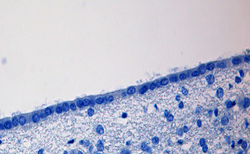Ependyma
| Ependyma | |
|---|---|
 | |
 Photomicrograph of normal ependymal cells at 400× magnification in human autopsy tissue | |
| Identifiers | |
| MeSH | D004805 |
| TA98 | A14.1.00.022 |
| TA2 | 5368 |
| FMA | 242791 |
| Anatomical terminology | |
The ependyma is the thin
neuroglia in the central nervous system (CNS). It is involved in the production of cerebrospinal fluid (CSF), and is shown to serve as a reservoir for neuroregeneration
.
Structure
The ependyma is made up of ependymal
glial cell. These cells line the ventricles in the brain and the central canal of the spinal cord, which become filled with cerebrospinal fluid. These are nervous tissue cells with simple columnar shape, much like that of some mucosal epithelial cells.[2] Early monociliated ependymal cells are differentiated to multiciliated ependymal cells for their function in circulating cerebrospinal fluid.[3]
The basal membranes of these cells are characterized by tentacle-like extensions that attach to astrocytes. The apical side is covered in cilia and microvilli.[4]
Function
Cerebrospinal fluid
Lining the CSF-filled
microvilli, which absorb CSF. Within the ventricles of the brain, a population of modified ependymal cells and capillaries together known as the tela choroidea form a structure called the choroid plexus, which produces the CSF.[5]
Modified tight junctions between epithelial cells control fluid release. This release allows free exchange between CSF and nervous tissue of brain and spinal cord. This is why sampling of CSF, such as through a spinal tap, provides information about the whole CNS.
Neuroregeneration
Jonas Frisén and his colleagues at the
lateral ventricle might be a source for cells which can be transplanted into the cochlea to reverse hearing loss.[8]
Clinical significance
tumor of the ependymal cells most commonly found in the fourth ventricle
.
See also
References
- ^ "ependyma". The Free Dictionary.
- ^ Histology, a text in atlas, M. Ross 2011, 6th edition page 367
- S2CID 3770948.
- ^ ISBN 978-0-443-06982-6, retrieved 2021-01-06
- ISBN 978-0-7817-9069-7.
- S2CID 9658786.
- S2CID 10479458.
- ^ "Brain cell hope for hearing loss". BBC News. 2008-12-09. Retrieved 2008-12-09.
External links
Wikimedia Commons has media related to Ependyma.
